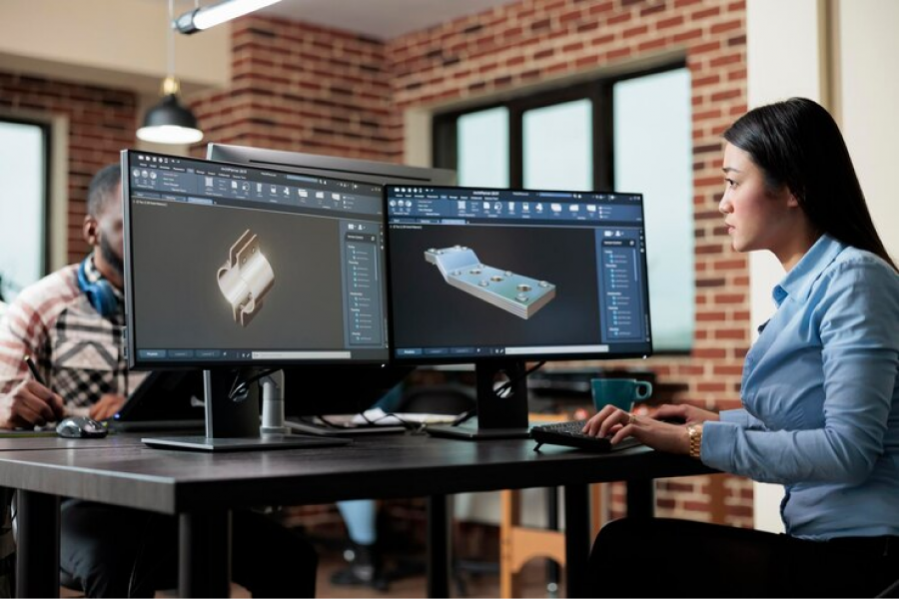THE IMPORTANCE OF CAD AND CAE IN PRODUCT DESIGN AND DEVELOPMENT
CAD software is used to create 2D and 3D product models. This allows designers to see the product from various perspectives and make changes quickly and easily. In addition, CAD software can generate detailed technical drawings that can be used in manufacturing and assembly. Product designers can use CAD to create complex designs that would be difficult or impossible to create by hand.
In contrast, CAE software is used to analyse products under various conditions such as stress, heat, and fluid flow. Engineers can then optimise the design for performance, reliability, and safety. CAE can also be used to ensure that products meet industry standards and regulations. Product designers can detect potential problems early in the design process with the help of CAE, saving time and money.
The advantages of using CAD and CAE in product design and development are obvious.

Faster iterations and collaboration:

Product design and development have been transformed by CAD and CAE software, which allows for faster iterations and collaboration. Previously, designing and developing a new product was a time-consuming and labour-intensive process that involved numerous physical prototypes and testing phases. However, with the help of CAD and CAE, designers and engineers can work more efficiently, reducing product development time and cost.
CAD software enables designers to create 2D and 3D product models that can be easily modified and updated. Changes can be made quickly and easily, allowing for faster iterations. Additionally, CAD software provides a common platform for designers and engineers to collaborate and communicate on.
Engineers can use CAE software to analyse products under various conditions such as stress, heat, and fluid flow. This means that potential issues can be identified and addressed early in the design process, eliminating the need for physical prototypes. Engineers can use CAE to optimise designs for performance, reliability, and safety, resulting in better products.
In product design and development, combining CAD and CAE allows for faster iterations and collaboration. Designers can use CAE software to create digital models of products that can be quickly modified and tested. This means that changes can be made and tested quickly without requiring physical prototypes. Designers and engineers can collaborate more effectively when using digital models, resulting in better products.
Virtual Testing:
Engineers can use CAE software to analyse products under various conditions such as stress, heat, and fluid flow. This means that potential issues can be identified and addressed early in the design process, eliminating the need for physical prototypes. Engineers can use CAE to optimise designs for performance, reliability, and safety, resulting in better products.
In product design and development, combining CAD and CAE allows for faster iterations and collaboration. Designers can use CAE software to create digital models of products that can be quickly modified and tested. This means that changes can be made and tested quickly without requiring physical prototypes. Designers and engineers can collaborate more effectively when using digital models, resulting in better products.
CAD and CAE work together to enable virtual testing and analysis of product designs, eliminating the need for physical testing and prototyping. This can speed up the product development process, reduce costs, and improve overall product quality. Furthermore, virtual testing can be used early in the design process to identify potential issues, allowing for more efficient problem-solving and optimization.

Errors and design flaws:

Designers can use CAD software to create detailed digital models of their products, which can then be easily modified and refined throughout the design process. This can aid in identifying and correcting errors early in the design phase, prior to the production of physical prototypes. Furthermore, CAD software allows designers to visualise their designs in 3D and test different design iterations, which aids in the optimization of the final product design.
CAE software, on the other hand, employs mathematical models to simulate real-world conditions and test product performance under various scenarios. Engineers can use this to identify potential issues and design flaws before creating physical prototypes.
CAE can be used to analyse stress and strain in a product, for example, to ensure that it can withstand the forces it will be subjected to in real-world use.
CAD and CAE can help to reduce errors and design flaws in product design and development by allowing for virtual testing and analysis. This can save time and money by eliminating the need for physical testing and prototyping, while also improving the final product’s quality and reliability.
Conclusion:
Finally, CAD and CAE are important tools in modern product design and development. They allow for faster iterations and collaboration, as well as virtual testing and the reduction of errors and design flaws. As a result, CAD and CAE software are invaluable to any company seeking to design and develop high-quality products in an efficient and cost-effective manner.


